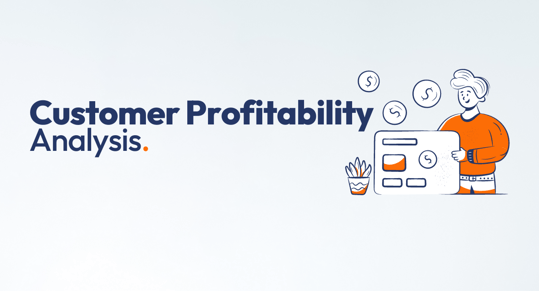Share this
FREE Customer Profitability Analysis Templates + How to Get Started
by Julie Bennett on November 20, 2023

It’s important for any business to know who their most profitable customers are.
If you’re a juice bar, your customers who spend the most may necessitate some extra attention. If you’re a consultancy firm, your least profitable clients may not be worth another contract renewal… and so on and so forth.
To figure out who earns you the biggest margins and the most net revenue, best practices dictate that you perform a customer profitability analysis.
Doing a customer profitability analysis isn’t necessarily complicated, but you’ll need to get your hands on the correct data, i.e. how much each customer actually costs and how much they actually earn the business.
From there, simple formulas will get you to your answers.
Using a template is a great way to save time on doing a profitability analysis. We’ll show you a few no-mess, 100% FREE templates you can find online (no credit card required).
What is a customer profitability analysis?
Let’s start even more basic with this question– what is customer profitability?
Here’s a great answer from our partners at HubSpot:
Customer profitability is a measure of how profitable a specific customer is. This metric compares how much revenue a given customer generates with the company's spending on acquiring or retaining that customer — in time, resources, or other costs.
Ipso facto, a customer profitability analysis will help you arrive at specific figures that tell you how profitable your customer is.
How to perform a customer profitability analysis
To perform a customer profitability analysis, you’ll need to figure out how much revenue the client generates plus how much it costs your firm to service that client.
To get your hands on these numbers, you’ll need to take a look at your project data to see how much time, expense, and other resources have gone into said client.
You’ll also need to check your CRM for reports on marketing and sales costs incurred.
Take a look at your invoicing data in your accounting solution to see how much has been paid out by the customer.
If you’re in professional services and use a project-based revenue model, you’ll then put these numbers together to figure out:
- Net customer profit - Total net profits from all projects & contracts
- Customer net profit average (if applicable) - Total net profits from projects/# of projects
- Customer profit margin - (Total costs for customer/Total customer revenue) x 100
- Average customer profit margin per project - Total project profit margins for customer/# of projects
These figures from your customer profitability analysis will let you know how much money the customer brings in after costs, the average profit they bring in per project, and your profit margins on that customer.
It’s also recommended to engage in some kind of time and energy analysis. That is, after you know the cold, hard numbers, garner feedback from your team as to whether or not their time and energy is put to good use for said profits. This can go a long way in promoting empathy in your company culture and developing soft skills in your organization.
For more details on how to do a customer profitability analysis, check out this article to get a good feel for what you need.
FREE Customer Profitability Analysis Templates to Get You Started
Ready to do your customer profitability analysis? Make things easy with a template. You can easily do your profitability analysis with Excel or Google Sheets.
There are lots of free templates that pop up on Google, but not all of them are actually free. Many will make you subscribe and/or enter your credit card info.
Not here. These are truly gratis, no strings attached. Here are 10 FREE customer profitability templates to choose from:
For Customer Profitability via Buyer Personas
A great way to stay on top of your profitability, particularly if you’re in ecommerce, is by segmenting your customer base with what’s called buyer personas. Here’s a link to HubSpot’s buyer personas template, along with a customer profitability example template below:
For All Growing Businesses (Catch-All Template)
For medium-sized businesses and really all businesses who are growing, this downloadable FREE customer profitability template (Excel) is a great tool from Rhythm Systems to help CEOs and owners get a handle on who are their most profitable clients.
For a Powerpoint Presentation
Need to present your customer profitability analysis in a powerpoint presentation? This FREE template is a great place to start.
For Power BI
Power BI is a great resource to generate all sorts of reports. Learn how to configure your customer profitability report with this sample here. FYI– you can get this custom template using the free Power BI license.
Option B– Forget templates. Let PSA software do your profitability analysis for you.
Profitability analysis is exponentially easier when you don’t have to do any of it yourself. The most tedious part of the analysis is finding all your numbers, which may ‘live’ in various software solutions and spreadsheets.
Getting a hold of all that information can take up a lot of time. Not to mention, all that manual data entry can leave you vulnerable to errors…
There’s a better way!
Professional service businesses can simply use PSA software to generate customer profitability reports with a couple clicks.
Instead of spending time trying to locate all your relevant data for customer costs– from marketing to time and expense spent on services, etc– all this information can be aggregated from a PSA tool that’s integrated with your CRM. The PSA solution then simply generates the report.
For example, you can use the Smart Quotes feature by PSOhub to run profitability reports that can show you your margins on all your customers.
Because PSOhub integrates with HubSpot, Salesforce, and Dynamics 365, all your relevant customer data from both sales and projects can automatically be pulled into the report.
It’s the easiest, fastest, most accurate way for professional service businesses to find out their profitability metrics.
To see how it’s done, schedule a demo with PSOhub. Or you can dive right in and start your FREE trial today!
Share this
- Project Management (82)
- Productivity (61)
- Time Tracking (26)
- PSA Software (24)
- HubSpot (20)
- Resource Management (13)
- Invoicing (12)
- Salesforce (11)
- AI (7)
- Contract Management (7)
- Profitability (6)
- Gantt Chart (4)
- Microsoft Dynamics (4)
- Budget Management (3)
- Financial services (3)
- Integrations (3)
- Quickbooks (3)
- Quote (3)
- ROI (3)
- Traffic Management (3)
- collaboration (3)
- Consultancy (2)
- Digital Marketing & Advertising (2)
- Pipedrive (2)
- Work Management (2)
- About PSOhub (1)
- Automation (1)
- IT Companies (1)
- Risk Management (1)
- Ticket Sync (1)
- Workload Management (1)
- power bi (1)
- April 2025 (2)
- March 2025 (3)
- February 2025 (3)
- January 2025 (3)
- December 2024 (1)
- November 2024 (5)
- October 2024 (5)
- September 2024 (1)
- August 2024 (4)
- July 2024 (3)
- June 2024 (5)
- May 2024 (4)
- April 2024 (5)
- March 2024 (5)
- February 2024 (4)
- January 2024 (3)
- December 2023 (2)
- November 2023 (7)
- October 2023 (5)
- August 2023 (6)
- July 2023 (2)
- June 2023 (4)
- May 2023 (4)
- April 2023 (3)
- March 2023 (4)
- February 2023 (4)
- January 2023 (3)
- December 2022 (5)
- November 2022 (3)
- October 2022 (4)
- September 2022 (5)
- August 2022 (7)
- July 2022 (1)
- June 2022 (7)
- May 2022 (6)
- April 2022 (2)
- March 2022 (2)
- February 2022 (4)
- January 2022 (4)
- December 2021 (5)
- November 2021 (2)
- October 2021 (2)
- September 2021 (3)
- August 2021 (3)
- July 2021 (2)
- June 2021 (2)
- May 2021 (3)
- April 2021 (2)
- March 2021 (2)
- February 2021 (3)
- January 2021 (5)
- December 2020 (4)
- November 2020 (2)
- October 2020 (4)
- September 2020 (5)
- August 2020 (4)
- July 2020 (4)
- June 2020 (1)
- May 2020 (4)
- April 2020 (8)
- March 2020 (7)



